You are finally going to start getting serious about four wheeling and need to learn everything you need to know? There’s a lot more to it than you might think! You have to get the right ATV and gear, learn how to operate the quad, learn proper riding technique and figure out how to properly care for your new four wheeler (If you are buying a used ATV, you must review this guide). There is a lot there, but we are going to walk you through all you need to know and point you at some great resources you should review. Happy riding!
What you needLuckily, you don’t need a whole lot to get started. Really, you need the ATV and you might be able to get going, but there are some other things that are going to keep you safe and make the experience a lot more enjoyable.
Get the right ATVThis is the most important step to getting started. You have to get yourself a four wheeler. While it is tempting to just jump on the first good deal you find, you want to take the time to figure out what machine is going to be best for you and the riding you want to do.
There are two types of ATVs – sport quads and utility quads. Sport quads are typically not best for new riders. They are fast, can handle some jumps, are usually two wheel drive, have manual transmissions (you have to operate the clutch and shift), and are much lighter than the utility quads.
The utility ATVs usually have automatic transmissions (just like an automatic car, you don’t have a clutch and don’t shift), are heavier, come in both two-wheel drive and four-wheel drive, have more storage space, a more comfortable seat, and are more compatible attachments such as winches, snowplows, rack boxes, chainsaw holders, gun racks, and so forth. You also may want to consider if a UTV (side by side) is a better fit for you. These are typically better for hauling cargo or people, but there are some awesome sport options available too. See more about whether an ATV or UTV is right for you with this guide.
Once you figure out whether you want sport or utility quad, you have to figure out what size ATV you should get. This is going to depend on a lot of different factors. First of course is your size, but you also have to look at where you are going to ride, how you are going to ride and whether you are going to let others ride your ATV. We go into a ton of details in this guide to picking the right sized ATV, but a summary is below.
This is going to depend on a lot of different factors. First of course is your size, but you also have to look at where you are going to ride, how you are going to ride and whether you are going to let others ride your ATV. We go into a ton of details in this guide to picking the right sized ATV, but a summary is below.
50-70cc-young children under 12 that are learning to ride.
90-125cc-children under 16 that are still learning to ride.
200-300cc-bigger teens that know how to ride, smaller adults that are learning, wont be riding for long periods of time
400-500cc – price point shoppers, ranchers, acreage owners, farmers, new riders, light trail riding, most females
550-700cc- – aggressive trail riding, hauling, taller people,
700-1000cc – aggressive trail riding, mud play riding, average male rider, hunters, hill climbers, speed demons, stream crossers
There are going to be some other key considerations you need to look into when picking out an ATV. You will want to read this article to help you make a decision on all the other features, but a few of the most important considerations are the following:
You will want to read this article to help you make a decision on all the other features, but a few of the most important considerations are the following:
Once you pick out the right ATV, you are ready to get riding; however, you should get some of the essential safety gear to keep yourself safe and make your ride more enjoyable. For starters, get yourself a good helmet, goggles, boots, and gloves. Though expensive, you’ll be happy you got them if you wipe out. Of course, the best place to pick out the gear you need is our Recommended Gear page!
Though expensive, you’ll be happy you got them if you wipe out. Of course, the best place to pick out the gear you need is our Recommended Gear page!
You shouldn’t get to bogged down with buying a lot of accessories or modifications when you are first starting, but there are just a couple we think are worth considering.
First, a winch is a relatively cheap investment that can be especially helpful for a new rider on rough terrain. If you slide off a trail or get yourself stuck in the mud, the winch can pull you out of the tough spot. To learn more about picking out a winch and see a great one we recommend for most riders that is under $200, check out our recommendations.
The other accessory that could be good for a new rider are nerf bars. As a new rider, you’ll have enough to think about without worrying about what to do with your feet. With Nerf bars and heel guards, you’ll get the stability you need so you can ride more comfortably. Nerf bars are like giant foot pegs that help you to easily keep your feet in place during your ride. Heel guards to the same thing on the other side of your foot, namely keeping your feet where you want them to give you more control while riding.
Nerf bars are like giant foot pegs that help you to easily keep your feet in place during your ride. Heel guards to the same thing on the other side of your foot, namely keeping your feet where you want them to give you more control while riding.
Before you jump on your ATV and start riding, there is some preparation you should undertake, especially if you have never ridden an ATV before.
Take a safety courseDepending where you are at, you should be able to find an ATV safety course. These courses will teach you how to safely ride an ATV. One of the best options for every new rider is to enroll in an ATV Safety Institute (ASI) ATV RiderCourse. It’s not expensive, and if you’re buying a new quad, you may get a certificate to take the course for free. Courses are usually broken up into three or four weeks, with them lasting two and a half hours a night once a week.
Read the Owner’s ManualI know that owner’s manuals are typically the most boring thing you could possibly read, but it is so important.![]() The owner’s manual on your new quad should provide operating tips, riding tips and directions on what you should and shouldn’t do with the ATV, especially before your first ride. Some manufacturers require certain steps be taken before starting the engine for the first time. The owner’s manual is also your go-to for maintenance schedules and buying the right replacement parts.
The owner’s manual on your new quad should provide operating tips, riding tips and directions on what you should and shouldn’t do with the ATV, especially before your first ride. Some manufacturers require certain steps be taken before starting the engine for the first time. The owner’s manual is also your go-to for maintenance schedules and buying the right replacement parts.
As you read the manual, sit on the ATV and get a good feel for where all the controls are. Most quads have a thumb throttle, not a twist throttle like dirt bikes. The throttle is typically located on the right side of the handlebars. The left handlebar of the ATV will probably have the electric start, headlight controller, a kill switch, and the front brake.
The rear brake is usually a foot pedal on the right side floorboard. The gear shift lever is also usually on the right side (except for Yamaha, which has theirs on the left) that has high, low, neutral, and reverse.
You also want to make sure your ATV is going to be comfortable for you once you learn where everything is and how it works.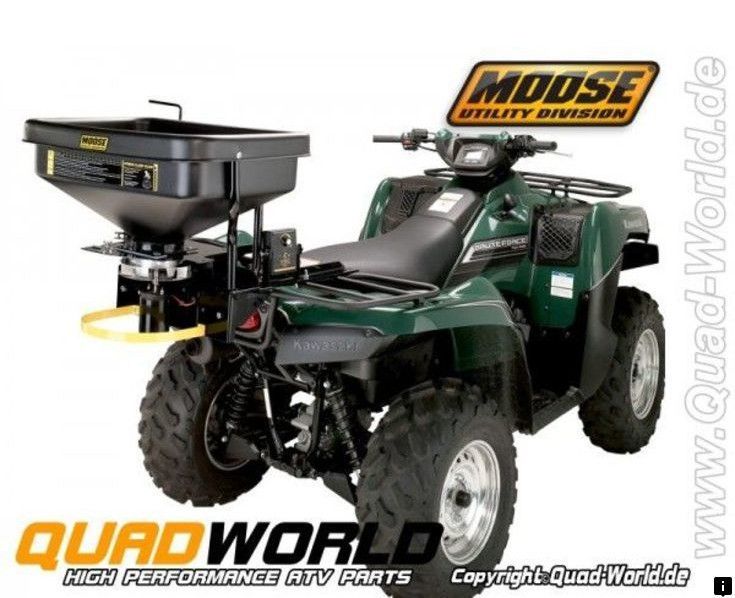 It’s unlikely you’ll sit on your ATV and be perfectly comfortable with the location of the handlebars and controls. Following your owner’s manual, adjust the levers, clutch and handlebars to your liking.
It’s unlikely you’ll sit on your ATV and be perfectly comfortable with the location of the handlebars and controls. Following your owner’s manual, adjust the levers, clutch and handlebars to your liking.
Not all states require registration or licensing, but some do. Some other states require a land-use permit or another type of land pass if you want to ride on public lands.
Other state rules and regulations regarding ATV safety may include guidelines for the required safety equipment (like helmets, gloves and riding boots), age restrictions, licensing, sound levels and safety training.
It is a pain to try and figure out what exactly is required since every state is different, but we did all the painful work for you. Check out our guide to the ATV laws for every state.
Besides state requirements, you also need to learn the requirements to operate an ATV on public land and roads. In addition to the state laws we linked to above, we published a guide for riding on federal lands.
Depending on the condition of your four wheeler, there is going to be a different level of maintenance you need to handle, but even with a brand new machine, there are a few basic things you should do before your start riding. To work on your ATV and check everything, you should get a few needed tools as well.
Check fluid levelsYou should always check the oil, fuel, and coolant levels to make sure they are adequate, and you should also look for any leaks in the various systems.
Check your air filterYou want to make sure your air filter is both clean and oiled. Even if your ATV is brand new, the air filter will be clean, but it might not be oiled. If you’re brand new to ATV riding, then oiling your air filter may be unfamiliar, but it is essential. If your air filter is dry, use some air filter oil on it before putting it back in the airbox. If the air filter is really dirty, swap it out for a new one.
Checking your tire pressure should be one of your regular checks before every ride. Especially before your first ride on an ATV, there is a good chance you will need to add quite a bit of air before that first ride.But don’t add too much. Over-inflated tires are more likely to pop or get damaged and under-inflated tires can ruin the rims. You’ll need a low-pressure tire gauge to get the job done.
Gas and oilIf you are like me, you excitedly ride your ATV until it runs low on gas for the first time, then think for the first time about whether you can put regular gasoline in your ATV. The answer is mostly simple luckily. For most four-stroke ATVs, you can use regular gasoline, grade 87 or above, from your local gas station. If you don’t know the recommendation for your ATV, opt for 89 grade unless the 87 grade is ethanol free. For oil, simply use 10w40 and change it a couple times a year. If you have a two-stroke ATV, the answer is a little more complicated.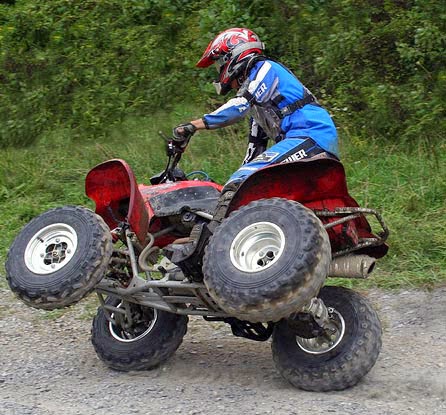 On a two-stroke ATV, you will need to mix gasoline with oil specifically designed for two-stroke engines and then use that gasoline-oil blend in your ATV. While the answer seems mostly simple, there are a lot more considerations with putting gasoline into an ATV than with filling up your average car, but you are in luck because we have answered all the questions you could have about gas and oil already.
On a two-stroke ATV, you will need to mix gasoline with oil specifically designed for two-stroke engines and then use that gasoline-oil blend in your ATV. While the answer seems mostly simple, there are a lot more considerations with putting gasoline into an ATV than with filling up your average car, but you are in luck because we have answered all the questions you could have about gas and oil already.
While you are checking the tire pressure, check the wheel nuts and axle nuts to make sure they aren’t loose or broken. Even new ATVs frequently arrive with loose lug nuts, so it is always smart to tighten and properly torque (you’ll want our favorite torque wrench) each lug nut on all four wheels Then, grab the tires and rock them back and forth to try and detect worn-out bearings. Next, check all the levers like the brake levers, throttle, and foot
Loading and TransportingNow that you have an ATV, you have to get your ATV to the riding location. Unless you are just going to be riding around your own property, you need to get a handle on how you are going to load and transport your quad.
Unless you are just going to be riding around your own property, you need to get a handle on how you are going to load and transport your quad.
One of the easiest solutions is to load the ATV in a truck bed, assuming you have a truck. Unless you have a short bed, you are going to mostly be okay. We have a guide for basically every truck and every bed combination out there and what size ATV you can fit in the bed.
A couple things to keep in mind when loading an ATV in a truck bed-you don’t want to let the ATV sit on your tailgate if it is too heavy, you shouldn’t load the quad by yourself, and you shouldn’t ride the ATV onto the truck. You also want to make sure you get a decent set of ramps. We have some guidelines you should follow in our recommendations.
If a truck bed isn’t going to work for you, you need to figure out what size trailer you need. We have all kinds of guidelines you should review when you are buying a trailer, but the short answer is that you can fit many single ATVs in a 4 x 6 foot trailer, although a 5 x 8 foot trailer will fit any single ATV much more comfortably.
For two ATVs, you will need at least a 6 X 12 trailer loading nose to tail or 6 X 10 foot if you can load side by side. You can also get away with a 6 X 10 trailer for most ATVs by loading one of them sideways and one normally. If you are getting into larger ATVs, bigger than 550cc I would say, you need to look at the dimensions to see if you are going to need something even bigger like a 7 X 12. For three or more ATVs, You are going to want to run your measurements, but will likely need at least something 16 feet long
Starting your ATV
How to start your ATV is going to depend on what type of quad you have. Luckily, If you have read your owner’s manual, you should already know how to start your quad and get it running.
Typically, an ATV starts either by a pull cord or by turning a key and pushing the starter button. If you are just starting off, hopefully you bought an ATV with an automatic transmission. If that is the case, you simply need to put the ATV in gear, usually by moving a lever forward. Then, slowly press the throttle to get going, which is usually done by pushing a thumb lever forward or twisting the right hand grip.
Then, slowly press the throttle to get going, which is usually done by pushing a thumb lever forward or twisting the right hand grip.
Before you do anything aggressive or head out on a trail, you are going to want to practice a little bit to get familiar to your quad and how it handles. We recommend finding a large, flat, open area to practice that is free of obstacles and hazards. In addition, practicing on a hard dirt surface will make it easier for you to learn the basic maneuvers. Do not practice on public roads or paved surfaces as accidents are much more common on paved roads since ATVs are designed for off-road use only.
If you are teaching a child to ride, there are a lot more considerations you should review in our key tips for teaching children to ride ATVs.
As you practice, work on getting a feel for the acceleration and braking, then move on to turning. After you’ve gotten completely familiar with the ATV, including where the controls are, how to operate everything naturally (without thinking about what does what), and how to turn comfortably using your body-weight, then you can start opening up a little bit at a time.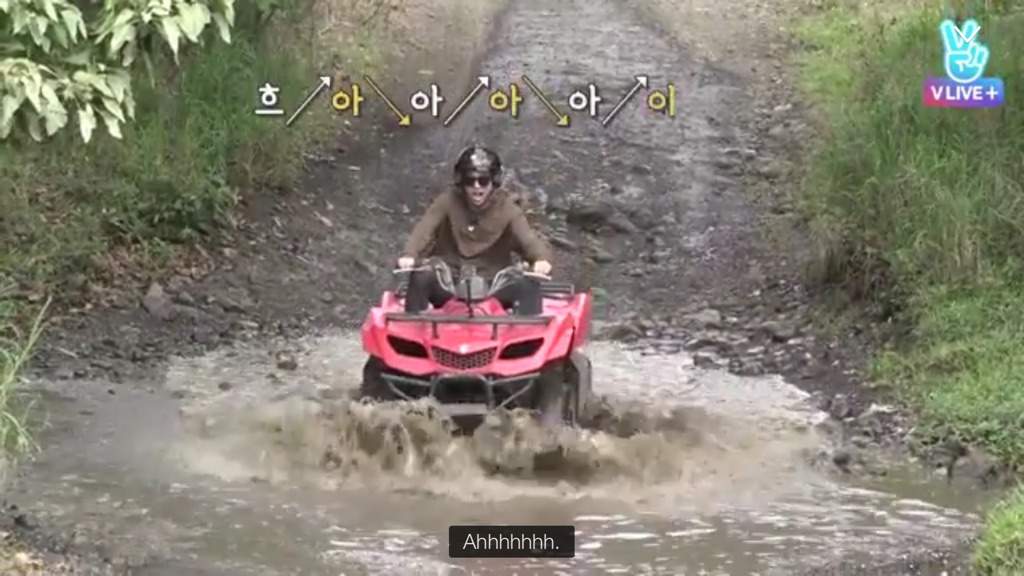
Once you are comfortable in an open area, start with some simple trails before slowly advancing to more complicated terrain.
As a new rider, you need to stay completely focused on what you’re doing and where you’re going. Don’t drive so fast that you outpace your line of sight or your brakes. Practice starting, stopping and turning over and over until it just comes naturally. There’s nothing that will increase your riding ability like lots of practice.
PostureHaving the correct riding posture will help you to easily operate the controls and help you react more quickly when shifting your body weight. You should practice with the proper posture from the very beginning to ensure you don’t learn bad habits. Proper riding posture, when you are traveling straight, includes:
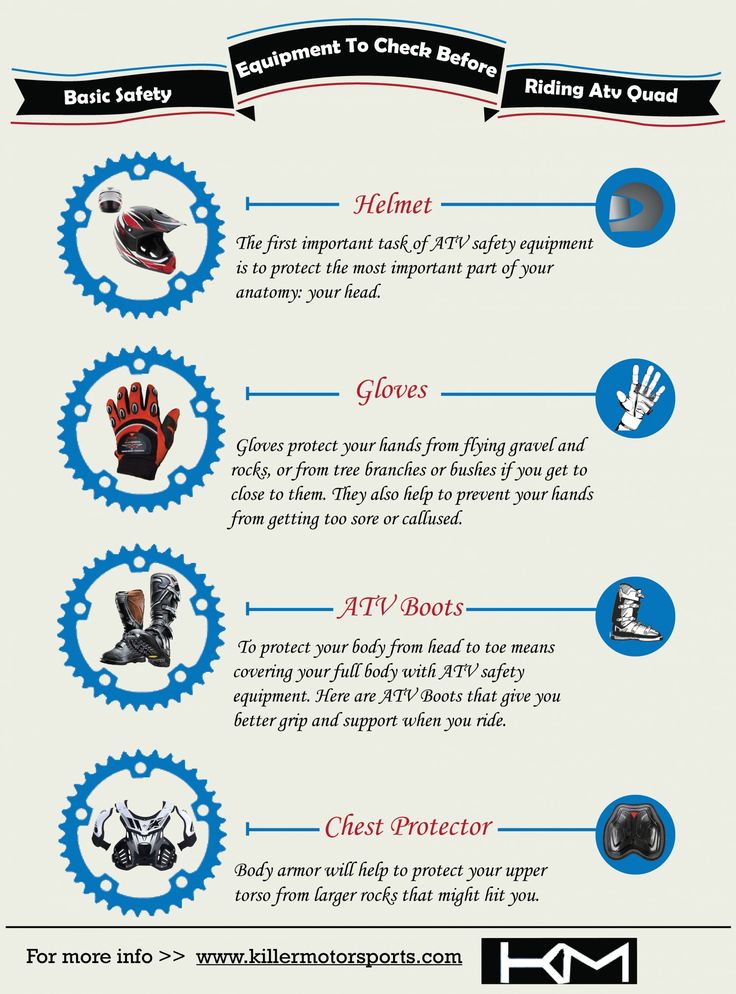 It gives you less control over the ATV and proves painful when you hit a bump.
It gives you less control over the ATV and proves painful when you hit a bump.Standing up on an ATV may seem a little wild for a beginner, but it is actually safer in most situations. If you’re in for just a casual stroll down a trail, then your are more than okay to take a seat for your ride.
On the other hand, if you’re wanting to ride at some higher-speeds and take some sharper turns, you need to stand-up. It’s makes it easier to control your quad, reduces fatigue and makes for a better ride. When you stand on an ATV, you want to hover just above the seat, keeping your elbows out and your knees bent.
TurningTurning in an ATV is an art form. As you get more advanced, you can get more aggressive with your cornering and have a lot of fun.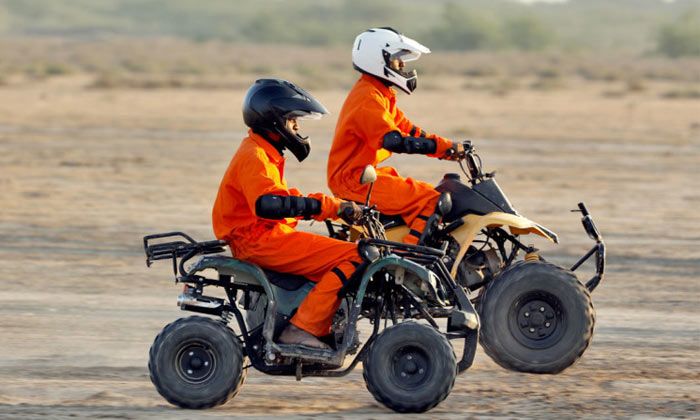 When you are just starting, you should stick to the basic turning techniques appropriate for ATVs being ridden at low to moderate speeds:
When you are just starting, you should stick to the basic turning techniques appropriate for ATVs being ridden at low to moderate speeds:
Most ATVs have a reverse gear. Every ATV I am aware of comes with a rev-limiter that is activated when the ATV is in reverse to limit the speed you can drive in reverse. While that may seem annoying, it is actually super helpful because it is really difficult to handle an ATV in reverse and you will quickly lose control if you are going to fast in reverse.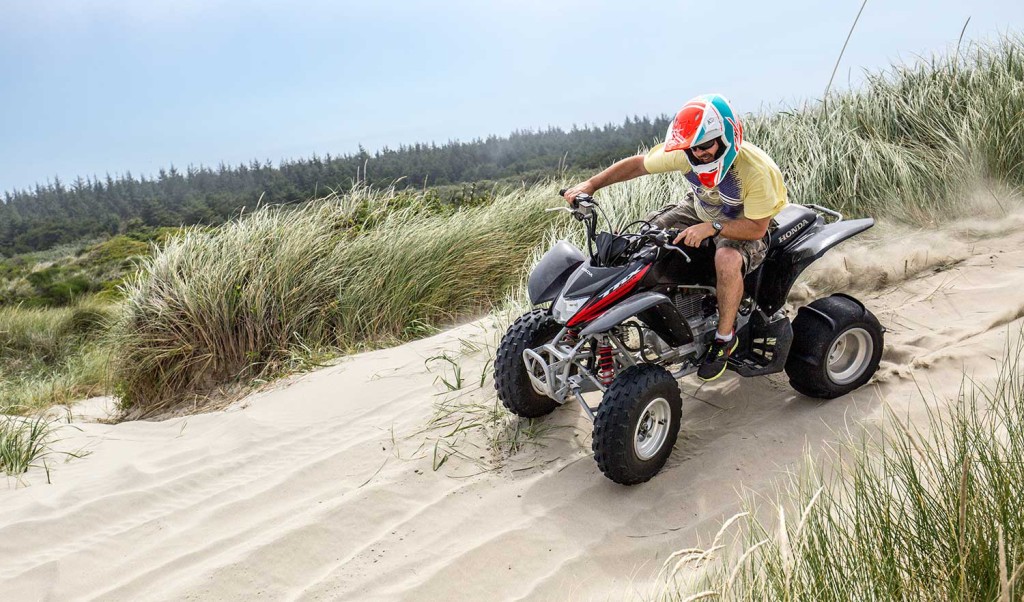 If you really want to go faster in reverse, many ATVs come with the option to reverse the rev-limit via an override button. This can be helpful if you a stuck in a tough situation like a mud bog or snow bank. Unless you are in one of these tricky situations, just leave the rev-limiter in place and rever slowly and carefully, especially while you are still getting accustomed to riding ATVs.
If you really want to go faster in reverse, many ATVs come with the option to reverse the rev-limit via an override button. This can be helpful if you a stuck in a tough situation like a mud bog or snow bank. Unless you are in one of these tricky situations, just leave the rev-limiter in place and rever slowly and carefully, especially while you are still getting accustomed to riding ATVs.
One of the big choices we discussed above is whether you want four-wheel or two-wheel drive. If you opted for a 4WD ATV, the first thing you will need to figure out is when you should use the four-wheel drive. Four-wheel drive is going to be beneficial when you are on rough terrain or tackling obstacles such as hillclimbs, logs, ledges, snow, ice, mud bogs or rock fields.
You don’t want your ATV in 4WD all the time though. You will definitely feel the difference. When your quad is in 4WD, the steering is going to be rougher and your engine works harder, impacting your gas mileage.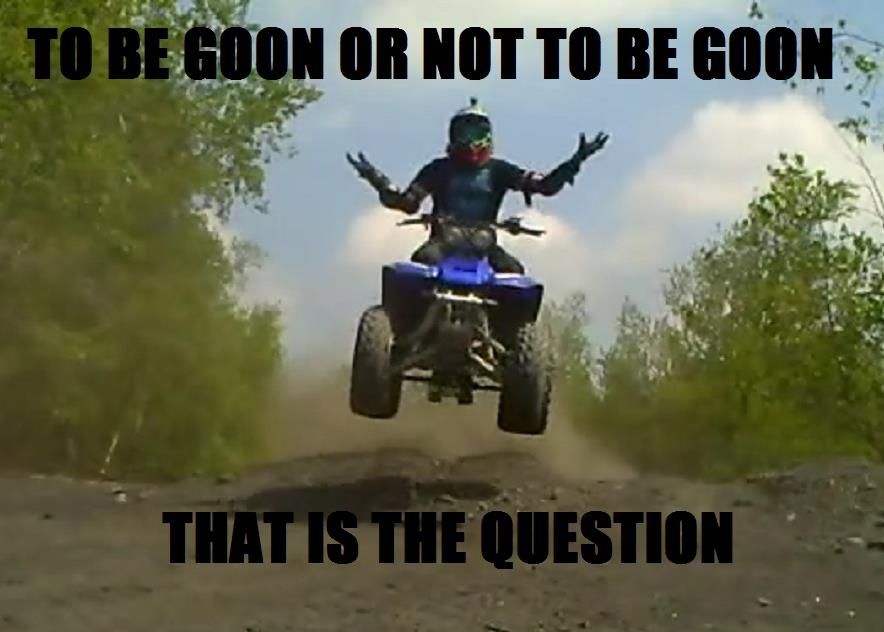
If you are going to do any kind of trail riding, you will have to learn how to climb hills. Climbing hills improperly could cause loss of control or cause the ATV to roll over on you. While climbing hills seems pretty easy, there are some key things you will need to learn and follow.:
The best technique for approaching an uphill climb is to:

If you are cruising up the hill and then realize you do not have enough power to reach the top of the hill, you need to know how to handle the situation. Ideally, you will come to this realization while you still have forward momentum and enough room to turn around and head back down the hill. To execute a safe U-turn:
If you are in the unfortunate position where you are riding uphill and don’t realize you won’t make it until you lose all forward momentum, follow these steps:
Always check the terrain carefully before you start down any hill. Choose a downhill path that is as straight as possible, with a minimum of obstacles and the least steep as possible. Shift your weight to the rear of the machine and use a low gear. On steeper downward slopes, straighten, but do not lock, your knees and elbows. You should use both brakes to gradually slow down, but whatever you do, always apply the rear brake. If you only apply the front break, you are going to flip right over your handlebars, likely getting crushed by your quad
Most of the time when you are going up or down a hill, you will want to go across the slope rather than directly up or down the hill. This is called traversing and requires different techniques.. Before getting in the technique, you should never traverse slopes with excessively slippery, rough, or loose surfaces.
If you have found a safe slope for traversing, here’s the technique you should follow:
Unless you are on a well maintained trail, you are likely going to run into some obstacles out on the trails. Whether it’s a rut, boulder, or log, there’s a way to get over it safely. Unless it is too big of course. Generally, you shouldn’t try to get over anything thicker than 2 feet (think telephone pole) unless you have a big quad and lots of experience. If the obstacle isn’t too big, just follow these guides for getting over small obstacles blocking your path:
While having four-wheel drive is absolutely beneficial for getting through mud, it is not essential in most situations. Without 4WD, you basically have two options to get through a mud puddle.
First, the most fun and most dangerous, and least recommended, way is to fly through it at top speeds, enjoy the wave of water hitting you, and pray you don’t hit something buried under the water or mud.
Second, the safer method is to find ruts hopefully made by a previous rider. Go through the mud puddle with your tires on top of the ruts, one in the middle of the two ruts, and one on the outside. As you are working through the mud, don’t give it to much gas or you will spin your tires. This is going to get you all muddy and cause you to slip into the rut or to form your own new rut.
If you do start to get into a rut, you want to get out as soon as possible before you get stuck. In this situation, you are going to have to give it some gas, let the tires spin, and rock your quad back and forth until the tires catch something solid and shoot you forward.
Ending your rideAs you are ending your ride, you will want to put the ATV in neutral when you come to a stop. This will prevent you from accidentally accelerating as you dismount. Once you have come to a complete stop, set the parking brake as directed in your owner’s manual.
Once you are done riding for the day, your last thought should be toward keeping your ATV safe from thieves. Unfortunately, ATV theft is way too common, and you should absolutely take the threat seriously. We even published 21 tips you should be following. For example, you should always remove the key, lock the ATV to something solid and keep it close your house or camp just for starters.
Riding an ATV is a fun way to explore the outdoors, and getting all geared up with appropriate riding clothes and equipment is all part of the excitement. But before you set off into the beckoning trails, it’s essential to learn how to drive an ATV safely and correctly.
To drive an ATV, start with pulling in the clutch. Next, shift from neutral gear to first gear, then press the throttle slowly while gradually releasing the clutch. Once the ATV starts moving, you can shift through the gears to speed up. Brake the front wheels by squeezing the right hand lever. Brake the rear wheels with the right foot pedal.
If you’re new to ATVs and would like to learn how to drive one, here’s a quick start guide to get you started.
To get started, ensure you have a suitable ATV that beginners like yourself can drive. Try sitting on the ATV to feel how comfortable it is, and make sure that you can easily reach the handles and gears. Also, you want to avoid using an ATV that’s too powerful, big, or unwieldy, as this could end up causing an accident while you’re still learning.
For more info on buying an ATV check out my How To Shop For an ATV Guide.
When you start riding, select a wide, flat, and open space without hazards or obstacles in the way (fallen trees, sticks, ditches). Until you’re comfortable using the ATV’s controls, you may want to avoid steep terrain, vehicles, or objects that would require you to navigate around them.
For a beginner, it might be easier to learn how to drive using an automatic ATV. However, with practice, a manual clutch isn’t a bad choice either. The biggest hurdle is getting the coordination between your hands and feet right.
Here’s a helpful overview video before we get started, with more info below:
Now, here’s a step by step guide on how to drive an ATV:
To start the ATV, insert the key into the ignition, then turn it to the start position. Next, press the start button located towards the right of your handlebars. Once the engine starts, let it run for a minute or so to heat up. You can leave the engine running for up to 5 minutes before riding when the weather is cool.
To set the engine into neutral, pull the clutch lever located on the left handlebar. This action places the engine into neutral gear, allowing you to shift gears as you increase your speed. Use your left hand to engage the clutch and put the engine into gear to start moving. Remember that while in neutral gear, the ATV can continue moving forward, but you won’t manage to speed up at all. That’s because to start moving, you need to put the engine into first gear.
With the clutch still engaged, shift gears with your left foot by lifting the left footrest lever. Next, release the clutch to place the engine into gear, enabling you to keep moving. Then, shift upwards into higher gears as your speed increases.
Practice this move by riding around, increasing your speed gradually, and shifting into higher gears. This practice will help you get familiar with driving your ATV. Remember that you also don’t need to concern yourself with shifting gears if you’re riding an automatic transmission. Still, work on a gradual speed increase to get more comfortable driving the ATV.
When slowing down, you’ll need to downshift to lower gears. Downshifting allows you to match the gear with the ATV speed. Hold the clutch using your left hand and use your left foot to press the gear shift lever down before releasing the clutch. As you shift back to lower gears, you’ll sense the lever click down. It’s a good idea to downshift one gear at a time to give your engine time to adjust to the lower gears and slower speeds.
Levers on the right and left sides of the handlebars control your ATV’s brakes. The right-side lever controls the rear brakes, while the left-side lever controls the front brakes. Start to brake with the rear wheels first by squeezing the right handle. To add additional braking power, slowly press the left handle.
You want to avoid squeezing both brakes at the same time since you might topple over the handlebars. Furthermore, your ATV could also flip over if you press into the left handle to brake only the front wheels.
To distribute weight and prevent your ATV from tipping over, shift your weight into the direction you’re turning. For example, if you’re turning right, lean towards the right side of your ATV. Practice distributing your weight so that you can start taking turns at much higher speeds. A helpful trick here is to stand up from the seat when taking hard turns so you can lean further.
While you can take ATV driving lessons under an experienced rider, enrolling in a driving course is the best way to receive proper training. Once completed, you may also need to complete a certified course to enable you to drive your ATV legally.
Below is a short video explaining how to drive a manual ATV:
ATVs are powerful machines that can become unstable or difficult to manage at high speeds. They can also reach speeds of up to 65 mph (104.6 kph) or higher. And, their high center of gravity, lack of roll bars, seatbelts, or safety cages means they can tip or even roll over easily.
As such, you need to protect yourself from rollovers, collisions, and injuries that may come from riding ATVs. The following tips are useful in helping you stay safe on four wheels:
Mastering any skill takes time, and learning how to drive an ATV is no exception. However, with regular practice, you’ll acquire all the skills you need for a fun, long ride. Try out different terrains and work on your coordination to enhance your ATV riding abilities. Soon, you’ll be ready to go on off-road adventures.
Sharing is caring!
ATV riding techniques could be the subject of a full book. In the same article, we want to reveal to you the basics of safe riding. At first glance, there is nothing complicated in driving ATVs - you just need to steer and enjoy riding.
When driving over bumps, for example, those of the "wave" type, the driver must change his position all the time. So, when approaching an obstacle, you must shift your body back, otherwise you can hit the obstacle with your wheels. When driving over a bump, you need to move the body back forward, thus preventing excessive separation of the front wheels, i.e. rearing up the ATV. Then, when the rear wheels come off the ground, you need to move back again, otherwise you can fall out of the saddle, hitting your knees on the steering wheel.
Moving in a straight line at low speeds (up to 40 km/h), you can afford to relax. But at higher speeds or when passing sharp turns and slopes, the driver must move very actively. Indeed, due to the high center of gravity, short wheelbase and small width, ATVs are very prone to rollovers. In addition, if the motorcycle flies separately from the motorcyclist during falls, then the ATV most often covers the driver. Therefore, in order for ATV riding not to end with serious injuries, it is necessary to study the driving rules and strictly follow them.
ATV rider's weight is an important factor that affects machine handling. By shifting their weight, the driver can unload or load the front or rear of the ATV, thus compensating for centrifugal forces.
The first rule you need to learn is that when riding an ATV, you need to relax your arms. When driving, the driver can always let go of his hands, because his legs are holding him in the saddle. As the speed increases, the load on the legs also increases.
Conventionally, three racks are distinguished. The middle stance is used when driving in a straight line without turning. When opening the gas, the body must be moved forward to unload the hands. Thus, the front strut is obtained. When braking and closing the gas, the body, on the contrary, must be moved back, i.e. take a back seat. By the way, the word "stand" comes from the word "stand", and this name is not accidental. When actively riding an ATV, you do not have to sit. Standing on an ATV lowers your center of gravity. After all, there is a huge difference between the weight on a high saddle and the weight on the footrests. And the effect of shifting the body in a standing position is much greater than fidgeting back and forth on the saddle.
When going through a turn on a motorcycle, it is tilted inward, thus struggling with centrifugal force. But you can't do that with a quad bike. Therefore, it is necessary to use the weight of the driver. The main rule here is to always transfer the weight inside the turn. Moreover, it is necessary not only to tilt your shoulders. It is necessary to hang the entire body, including the fifth point. Only the shin and knee hold on to the saddle. Of course, if you turn at minimum speed, then you can limit yourself to turning the steering wheel.
The correct stance is characterized by slightly bent knees, elbows set apart, and a slightly arched and relaxed back. Why not stand on straight legs or keep your back straight and tense? Because bent knees allow you to absorb shock coming from uneven terrain. By the way, the force of these blows is sometimes quite enough to knock the driver out of the saddle. A straight tense back under such conditions can lead to injury to the intervertebral discs and even a compression fracture of the spine. Yes, and the internal organs with the wrong fit will have a hard time.
Active ATV riding requires good physical shape. So, in quad schools, the duration of the lesson does not exceed an hour, and at the end of the lesson, students can literally be squeezed out. And riding an ATV off-road is also an activity worthy of training in the gym.
When riding non-sport ATVs, it is best to avoid jumping. Firstly, this way you can break the ATV. Secondly, in order to safely perform such tricks, the ATV motor must have high-torque and fast response to the throttle. If, nevertheless, the jump could not be avoided, then it is necessary to land in the middle stance, but be ready to move to the back. When the wheels touch the ground, you need to slightly open the gas. It is better not to use four-wheel drive when jumping.
Every time you ride an ATV, you need to practice looking into the distance. This is necessary to develop the habit of evaluating the trajectory of movement in advance. Beginners often do not have time to track the road, and at some point they are not ready to perform adequate actions. And another, very predictable obstacle, can become a problem for them.
| When moving along a slope, it is necessary to move the body to the opposite side of the slope.
|
Before you start climbing, you need to pick up speed. Then the resulting inertia will allow you to smoothly drive into the steepness. If you suddenly open the gas directly on the rise, the ATV may tip over. Climbing should be in the most forward stance and on medium gas. If the incline is too steep, the ATV may roll backward when the throttle is released. In this case, you should not brake with the front axle, not the rear. If the ATV starts to roll over, you can try to jump to the side, but this acrobatic stunt is unlikely to be successful.
If the driver moves his torso out of the turn, then his centrifugal forces will pull him to the outer radius, and in order to stay in the saddle, he will need to firmly grip the steering wheel. At the same time, the ATV will definitely try to roll over. To avoid such an unpleasant situation, it is always necessary to remember a simple rule - to shift the body only in the direction of rotation. Those. if we turn to the left, then we shift the body to the left side, and vice versa.
Descents must be made in the C-pillar. In this case, the arms must be extended and slightly bent at the elbows. There is no emphasis on the hands, you can even let them go, holding on with your feet. The steeper the descent, the more the driver must move the body back. The lower photos show the consequences of a descent in an incorrect landing. The main mistakes - the driver shifted the weight forward and pressed his hands to the body.
ATVs (all-terrain vehicles) are compact and versatile vehicles. They are used for extreme recreation and sports competitions. They can effortlessly ride off-road and rough terrain. Wide wheels and a powerful engine make it easy to overcome dirt roads, potholes, ravines and slopes. Many summer residents, hunters and fishermen prefer to travel on ATVs. They can carry goods. In winter, they replace snowmobiles. A trip on such motor vehicles brings a lot of pleasant emotions. However, quad biking is an extreme form of transportation. And it is better to do it with professional instructors of the QuadRider club. Unlike motorcycles and other vehicles, they have a short wheelbase, narrow width and high center of gravity. Improper driving often leads to rollovers. Important to know how to drive an ATV correctly to avoid dangerous accidents. Appropriate training and compliance with driving rules is a guarantee of safety not only for drivers, but also for pedestrians.
Before driving an ATV, you must do the following:
Operating a vehicle without a license and skills is fraught with serious injuries and large fines.
Strictly prohibited:
The rider's weight has a big impact on the handling of the ATV. Centrifugal forces are compensated by transferring body weight to the rear or front of the vehicle. Quads are a powerful technique, prone to tipping over and slipping. Wrong driving can cost lives. In this regard, it is necessary not only to know0126 how to ride a quad bike , but also to learn the basic rack.
When riding an ATV standing up, it is easier to avoid tipping over. There are 3 main stances common among ATVs. Each of them is used in certain situations.
A dangerous stance option is a tense back and straight legs. In this position, the body cannot absorb shocks and shocks. The spine and joints are subjected to enormous loads. In this situation, control over transport worsens.
The main ATV controls are located on the steering wheel. On the right handle are: throttle trigger, differential lock switch (2WD / 4WD / LOCK) and fuse. On all-wheel drive, cargo transportation, off-road driving and slippery roads are usually carried out. The differential lock ensures the synchronous rotation of the wheels. On the left side of the steering wheel is the ignition switch, engine start button, headlight switch and horn button.
Sit in a correct and comfortable position on the ATV. Place your feet on the footrests and place your hands on the handlebars. Insert the key into the ignition switch and turn it to the "ON" mark. Then depress the brake pedal and the electric starter button. Hold the starter button for 5 seconds until the engine starts.
When the motor starts, let it run for 1 minute. In the cold season, warm it up for about 5 minutes. Before you start driving, make sure that there are no obstacles in the way (other vehicles and pedestrians). To move off, shift the gearbox to overdrive H. Release the brake pedal and gently press the gas trigger with your right thumb until you reach the desired speed.
Slow down on curves and turns. Turn as far as possible. Entering the turn, lean your whole body and lower body into the turn. If you turn right, shift your body weight to the right. If you turn left, lean your whole body to the left side. In this way, you will avoid falling and overturning the ATV.
Correct gear shifting and ATV should be carried out after it has come to a complete stop. Release the throttle lever and press the brake pedal. Move the gearshift lever to the desired position. The selected gear indicator should light up on the instrument panel. The gear lever must be in the "H" (normal high gear) or "L" (low gear for extreme conditions) position. The "R" mode is used for reverse.
Pick up speed before entering the hillock. Drive only in a straight line. Move your body forward. Maintain a smooth speed after opening the throttle. Don't lose your vigilance. Try not to drive on hills, the angle of which exceeds 25 °. Climbing a hillock or a steep slope, do not step on the gas abruptly. Drive at medium engine speeds. If the ATV begins to roll backwards while climbing a hill, get up and apply the front brake. In this case, it is not necessary to use the engine power and the rear brake. If the quad has stopped, apply the rear brake and move the gear lever to park. Put the handcuff on the transport, turn around manually and try to repeat the ascent to the hillock again. To descend, take a back stance and bend your elbows slightly. Shift into low gear. To avoid tipping over, apply both front and rear brakes at the same time. Do it smoothly. Do not press the gas trigger when descending. Do not change the set trajectory of movement.
You need to drive down the slope in low gear, moving the body towards the top of the hill. Hang your body completely on the steepest slopes. On the slopes, you can not brake sharply and pick up speed sharply. If the slope is slippery and steep, try to take a different path.
Start braking well in advance before coming to a complete stop. To slow down, release the throttle. ATVs stop quickly. But in an emergency, press the foot pedal or brake lever. Stop on a level, level surface. After stopping, shift into neutral. This will help to avoid unforeseen situations when disembarking from the vehicle.
After learning how to ride the ATV, learn how to drive on flat terrain without obstacles and other moving vehicles. Make sure the brakes are working at low speed when starting, turning and stopping. At first, try to avoid jumps and high speeds. Also, avoid jumping when riding a sports ATV. With a sufficiently high power, quadrics cannot accelerate much. But, if you press the throttle trigger hard and sharply, the torque is quickly transferred to the wheels, and the ATV can jerk forward sharply. Try to avoid dangerous obstacles. Look always ahead. Don't press hard on the gas. Concentrate on the smoothness of the movement and the maneuvers being carried out.